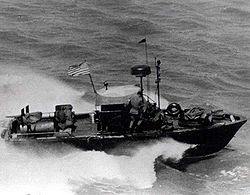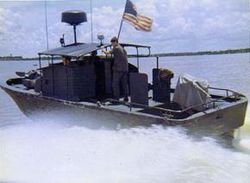- Patrol Boat, River
-

MK II PBRClass overview Name: PBR (Patrol Boat Riverine) Operators:  United States Navy
United States NavyPreserved: 1 operational General characteristics Type: riverine patrol boat Length: 31 ft (9.4 m) (Mk I)
32 ft (9.8 m) (Mk II)Beam: 10.5 ft (3.2 m) (MK I)
11.5 ft (3.5 m) (MK II)Draft: 2 ft (0.61 m) Propulsion: 2 × 220 hp (164 kW) Detroit Diesel 6V53N engines each driving a Jacuzzi Brothers water pump-jet with thrust buckets for reverse thrust. Speed: 28.5 knots (53 km/h). Complement: 4 enlisted Armament: 1 × twin M2HB .50 caliber (12.7 mm) machine guns (forward in a rotating tub)
1 × single M2HB (rear)
1 or 2 × M60 7.62 mm machine gun(s) (side-mounted)
1 × 40 mm Mk 19 grenade launcherArmor: Ceramic armor shields fitted to guns, bridge. Also crew-applied ballistic blankets to protect the coxswain in the control cockpit. 
Patrol Boat, River (also referred to as Pibber), or PBR, is the United States Navy designation for a small rigid-hulled patrol boat used in the Vietnam War from March 1966 until the end of 1971. They were deployed in a force that grew to 250 boats, the most common craft in the River Patrol Force, Task Force 116, and were used to stop and search river traffic in areas such as the Mekong Delta, the Rung Sat Special Zone, the Saigon River and in I Corps, in the area assigned to Task Force Clearwater, in an attempt to disrupt weapons shipments. In this role they frequently became involved in firefights with enemy soldiers on boats and on the shore, were used to insert and extract Navy SEAL teams, and were employed by the United States Army's 458th Transportation Company, known as the 458th Seatigers.[1]
Contents
Design
The PBR was a versatile boat with a fiberglass hull and water jet drive which enabled it to operate in shallow, weed-choked rivers. It drew only two feet of water fully loaded. The drives could be pivoted to reverse direction, turn the boat in its own length, or come to a stop from full speed in a few boat lengths.
The PBR was manufactured in two versions, the first with 31 foot length and 10 foot, 7 inch beam. The Mark II version 32 feet (9.8 m) long and one foot wider beam, had improved drives to reduce fouling, and aluminum gunwales to resist wear. It usually operated with four enlisted men, of which the most senior crewman was designated the Boat Captain. Often, however, a junior officer would be assigned as Patrol Officer of two boats.
Power
The boats were powered by dual 220 hp (164 kW) Detroit Diesel 6V53N engines with Jacuzzi Brothers pump-jet drives. The boats reached top speeds of 28.5 knots (53 km/h).
Armament
The boat were heavily armed for such a small vehicle crewed by just four persons. It was armed with twin M2HB .50 caliber (12.7 mm) machine guns forward in a rotating tub, as well as a single rear .50 cal, and side-mounted M60 7.62 mm machine gun and a Mk 19 grenade launcher. Sometimes a 20 mm cannon was mounted. By comparison, much larger WWII 80 ft PT boats which were later employed as gunboats had two twin .50 cal turrets, and 20 or 40 mm cannons, while small land vehicles such as the Humvee or M113 APC typically mount 1 .50 cal machine gun or even less. The machine gunners were protected with small ceramic armor gunshields, as well as the bridge area. The boats relied on speed and firepower for protection rather than the minimal armor fit.
US operations
PBRs were operating with the U.S. Navy Reserves up until 1995 at Mare Island, California prior to the base's closure that year. During the Vietnam War, Mare Island was home to the U.S. Navy's Repair Facilities, Mothballing Operations, Submarine Operations, and Riverine Training Operations for both Swift Boats and PBRs.
The training areas for the PBRs and Swift Boats still exist today within the "Napa-Sonoma Marshes State Wildlife Area". Sloughs such as Dutchman Slough, China Slough, Napa Slough, Devil's Slough, Susiun marshland and the Napa River all run through the former training area.
In the late 1990s, what remained of the U.S. Navy PBR force (Swift Boats had been retired from the U.S. Navy immediately following the Vietnam War during the early 1970s) was moved further inland towards Sacramento (State Capital), California, which is also intertwined with rivers. From Sacramento, PBRs can still transit directly to and through San Francisco Bay and into the Pacific Ocean, if need be. The waters of the State Wildlife Area, next to the former U.S. Navy (Riverine) training base at Mare Island, are still available for U.S. Navy PBR usage.
Medals
Patrick Osborne Ford was a United States Navy sailor serving on a PBR patrol boat who was killed in Vietnam after he saved the lives of two of his shipmates. The US Navy posthumously awarded him the Navy Cross and later named a frigate, USS Ford (FFG-54), after him.
Films and media
The TV series entitled Great Ships, sometimes shown on The Military Channel, History Channel and Discovery Channel, has one episode covering riverine warfare. Live footage showing some of the riverine boats is used, but tall metal electric power lines are visible in the background of the speeding PBRs. Additionally, blank firing adapters on the M2 machine guns, 1980s-era Woodland Pattern Battle Dress Uniforms and crew members wearing "K-Pot" Kevlar helmets confirm that the film is not from Vietnam-era combat operations. Although not mentioned by the narrator, these scenes are of U.S. Navy Reservists undergoing training at Mare Island, California.
A PBR is a usable vehicle in Battlefield: Vietnam and Battlefield Bad Company 2: Vietnam.
A PBR driven by Alex Mason and his MACV-SOG team in Call of Duty: Black Ops on a mission up river into Laos.
A PBR is the setting for much of the action in the film Apocalypse Now.
The PBR is also mentioned in Iron Maiden's song "The Edge of Darkness".
Colonel Le Monde's forces use the PBR, referred to as a "pibber", in the Electronic Arts game Nuclear Strike although the boats were never referred to as a "pibber" in the Navy.[citation needed]
See also
- Fast Patrol Craft: An all aluminum, 50-foot (15 m) long, riverine boat commonly referred to as the Swift Boat by the U.S. Navy's Brown Water Navy during the Vietnam War.
- Small unit riverine craft: Small armed and/or armored river craft used to maintain control of rivers and inland waterways.
Notes
- ^ 458th Sea Tigers. Accessed on 13 August 2009.
458th Sea Tigers (current website)
Further reading
- Friedman, Norman. U.S. Small Combatants, Including PT-Boats, Subchasers, and the Brown-Water Navy: An Illustrated Design History. Annapolis, Md.: Naval Institute Press, 1987. ISBN 0-87021-7135.
External links
- Gamewardens of Vietnam Association, Inc.—The oldest continuously operating Vietnam Veterans Organization in the United States, organized in 1968 by the Veterans of the Vietnam River Patrol Force, primary war boat, the PBR, River Patrol Boat.
- Rivervet website
- Riverine Force History
- PBR Forces Veterans Association
- HNSA Ship Page: PBRs as museums to visit.
Categories:- Patrol boats
- Riverine warfare
- Vietnam War ships
Wikimedia Foundation. 2010.

